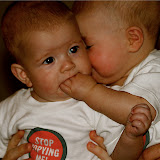
Every full moon, Sam and Amelia have a date night with their Mam. Last night Mam went all out! I have been gearing up for doing nature studies with them in Kindergarten, and I wanted to "practice" by doing a little study of the moon. I am getting a lot of my ideas from here. I mentioned this to mom and that the full moon was on Thursday and she went into action! She found ideas on making galaxy play doh, painting a neat textured moon, and then I found a few moon books we had ( Goodnight moon, a non fiction book about planets and moons, and Mooncake) and she sat up a beautiful table for them to have their time together (see the big white moon?:). That Mam, she's pretty amazing! We were a bit disappointed because none of us could actually see the moon and it was almost bed time, but then we got a text from a friend saying it was supposed to be visible shortly so we ran up to Sammy's room to look out his window. Oh. My. Gosh. We saw it rise up from behind the capitol, starting as a shimmer of gold and ending in its full moon glory. It was spectacular and we were all squealing and oohing and ahhing!
As a side note, I had never myself learned the moon phases and so one night I studied around using my Handbook of Nature Study, the website I mentioned, and online quizzes and learned them! So fun to be able to see the moon and say to myself, "Oh, look at that waxing Gibbous moon:)". We also learned that March's full moon is called the Full Worm Moon (among other things). Here is an explanation why, from the online Farmers Almanac:
• Full Worm Moon – March As the temperature begins to warm and the ground begins to thaw, earthworm casts appear, heralding the return of the robins. The more northern tribes knew this Moon as the Full Crow Moon, when the cawing of crows signaled the end of winter; or the Full Crust Moon, because the snow cover becomes crusted from thawing by day and freezing at night. The Full Sap Moon, marking the time of tapping maple trees, is another variation. To the settlers, it was also known as the Lenten Moon, and was considered to be the last full Moon of winter.




All for now! Jen
Oh, and P.S.
Look at this video from when Amelia was 18 months old and saw the moon. So sweet!!!




1 comment:
Too funny, I had to learn the names of the moon phases as well.
Post a Comment